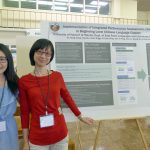Implementation of Integrated Performance Assessments (IPA) in Beginning Level Chinese Language Classes
Exploring possibilities for, and effects of, Integrated Performance Assessments (IPAs) in the Department of East Asian Languages and …


Exploring possibilities for, and effects of, Integrated Performance Assessments (IPAs) in the Department of East Asian Languages and …

Given the complex nature of the requirements for the 6 degree programs offered by the department of East …

Oral proficiency in Mandarin is one of the core language skills targeted by the Chinese program learning outcomes. …